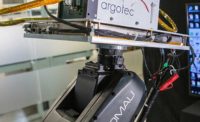Monitoring and meeting regulations is an ongoing challenge for every business, regardless of the products they make or the services they provide. Manufacturers of commercial electronic products, for example, must comply with strict electromagnetic compatibility (EMC) regulations. To achieve compliance, the manufacturers use electromagnetic interference (EMI) and electrostatic discharge (ESD) scanners early in the development cycle to verify that each product’s radiated emissions are within allowable levels.
San Jose, CA-based Amber Precision Instruments Inc. (API) has been making these types of scanners and integrating them into small-scale EMC test stations since September 2006. Well-known users of these stations include Samsung Electronics Co., LG Electronics and Intel Corp.
API’s initial station featured a vertical X-Y gantry with stepper motors, worm gears and custom-made parts. Because of the gantry’s complexity, system setup and programming took as long as one week. The system also presented inherent wiring and final-assembly challenges, was noisy and slow during operation, and lacked the ability to improve end-users’ takt time and device under test (DUT) sampling resolution.
Within a few years, API engineers replaced the gantry with a six-axis RV-3SD robot made by Mitsubishi Electric Automation Inc. The engineers made the change because the robot offers quicker station installation and programming, and its multi-axis control improves positioning accuracy and repeatability.
API began using the RV-3SD with its fully automated SmartZap station, which tests the immunity of devices to ESD. After mounting an ESD gun on the robot, the operator presses a button to trigger five system cameras to take images of the DUT (typically a PCB, mobile phone or tablet).
The measurement software analyzes these images to define the DUT’s geometry and calculate 3D points for testing. It then sends commands to the robot, which is equipped with TCP/IP communication, to position the gun to specific locations on the DUT. The end result is a comprehensive data map with localized ESD characterization information. An integrated conductive brush removes residual charges in the DUT.
According to Giorgi Muchaidze, system integration manager at API, the RV-3SD robot has not only significantly reduced setup time (down to one day). It has enabled the company to surpass its competition in test-station performance and product quality.
The RV-3D robot has a maximum load capacity of 3.5 kilograms and can be floor or ceiling mounted. Its motor is automatically tuned for optimal control based on operating position, posture and load condition. Repeatability is ±0.02 millimeter. An enabling-device input function ensures worker safety when the robot is operated by two persons. Using the optional enhanced teaching pendant eliminates the need for a PC at the test station.
Not long after changing the SmartZap setup, the company began equipping its SmartScan EMC test station with a four-axis RH-6SDH SCARA robot from Mitsubishi. Several manual and automated versions of the system are available, all of which feature a scanner that simulates the various fields produced by an ESD event.
For more information on six-axis and SCARA robots, call 847-478-2100 or visit http://mitsubishirobotics.com/.



